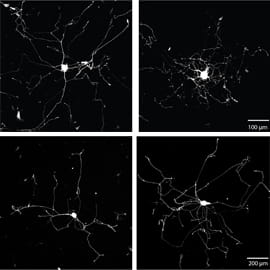Making Axons Branch and Grow to Help Nerve Regeneration After Injury
 By Rachel Ewing
By Rachel Ewing

One molecule makes nerve cells grow longer. Another one makes them grow branches. These new experimental manipulations have taken researchers a step closer to understanding how nerve cells are repaired at their farthest reaches after injury. The research was recently published in the Journal of Neuroscience.
“If you injure a peripheral nerve, it will spontaneously regenerate, but it goes very slowly. We’re trying to speed that up,” said Dr. Jeffery Twiss, a professor and head of the biology department at Drexel University in the College of Arts and Sciences, who was senior author of the paper.
But, Twiss said, scientists still have a lot to learn about how nerve cells repair themselves. He and his colleagues are especially interested in how nerve cells are repaired in their longest-reaching sections, their axons. Axons can be up to a meter long in adult human nerve cells, extending away from the cell body toward neighboring nerve cells, with which they exchange signals. Restoring length to damaged axons is essential to restoring nerve function, but coordinating these repairs at a great distance from the cell’s nucleus involves a mix of complex processes within each cell. To gain insight into these processes, they have focused research, including the present study, on repair proteins that are created locally near an injury site in a nerve’s axon.
Dr. Christopher Donnelly, now a postdoctoral fellow at Johns Hopkins University, led the study as part of his dissertation work in Twiss’ lab while at the University of Delaware.
Donnelly and Twiss knew from their previous research that two of the messenger RNA (mRNA) molecules involved in directing repair in injured axons compete against each other at an essential step in repairing damage. The mRNA molecules that “win” the competition get to make their particular repair-protein product.
So, experimentally, they rigged the competition between those molecules to see what would happen. Could one molecule make a difference in helping axons grow longer, faster?
The technical process of these experiments was complex, but the answers are easy to see.
The technical process of these experiments was complex, but the answers are easy to see.
Above: More branched growth in neurons (right) occurred when experimenters added more of the axonally targeted mRNA for the repair protein beta-actin.
They saw more branches in the axons when they added more mRNA used to make the repair protein beta-actin, while taking away the mRNA for the protein GAP-43.
They saw more branches in the axons when they added more mRNA used to make the repair protein beta-actin, while taking away the mRNA for the protein GAP-43.
Above: More elongated growth in neurons (right) occurred when experimenters added more of the axonally targeted mRNA for the repair protein GAP-43.
But they got the desired longer, less-branched axons from the opposite experiment, adding mRNA coding for GAP-43 and taking away that for beta-actin.
This was a promising result for developing potential therapies, Donnelly said. When nerves repair themselves after injury, there is currently no way to control their pattern of regrowth. But, “if you can induce longer growth quicker, rather than branching growth, you can help reach the target of faster recovery from an injury.”
Yet other modifications, selectively withholding the mRNA molecules, resulted in shorter axons, or in fewer axon branches – and the researchers found they could experimentally and selectively restore branching or lengthening growth in those deprived cells, too. Consistent with the first experiments’ results, adding more beta-actin mRNA again restored axon branching, and adding more GAP-43 mRNA again restored axon length.
But a key point in these experiments is that all of the changes only happened when they added mRNA molecules that functioned as the proteins’ “local recipe” used especially for making these proteins in the nerves’ axons. The “standard recipe” of mRNA, that directs cells to make those same proteins in the cell body, didn’t have these distinct effects on the axons’ growth.
This experimental technique to manipulate axon growth was not previously tested, the authors noted. They found most of these results using adult rat neurons in vitro, but also confirmed the principles in vivo with the developing spinal cord of chicken embryos in collaboration with Dr. Gianluca Gallo of Temple University.
“This sets some of the groundwork needed to consider using these mechanisms for improving regeneration in the future,” Twiss said. This basic science research will require further testing in animals before considering any advance to humans as an eventual possibility.
Drexel University has filed a patent application for the techniques used in these experiments to selectively drive translation of mRNA molecules of interest within axons.
Note: For any inquiries related to technology commercialization, contact Dr. Heather Rose in Drexel's Office of Technology Commercialization.
Drexel News is produced by
University Marketing and Communications.
